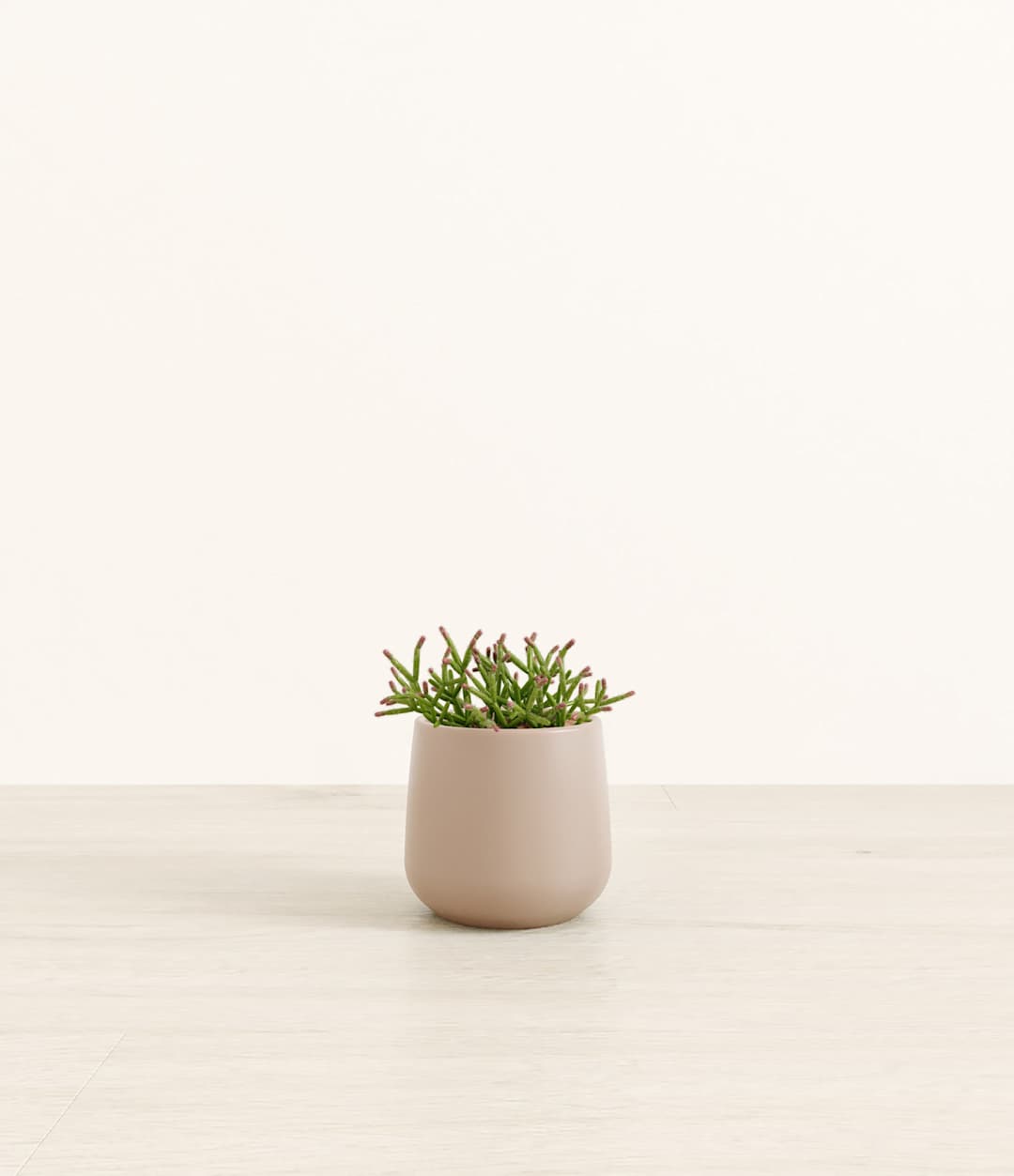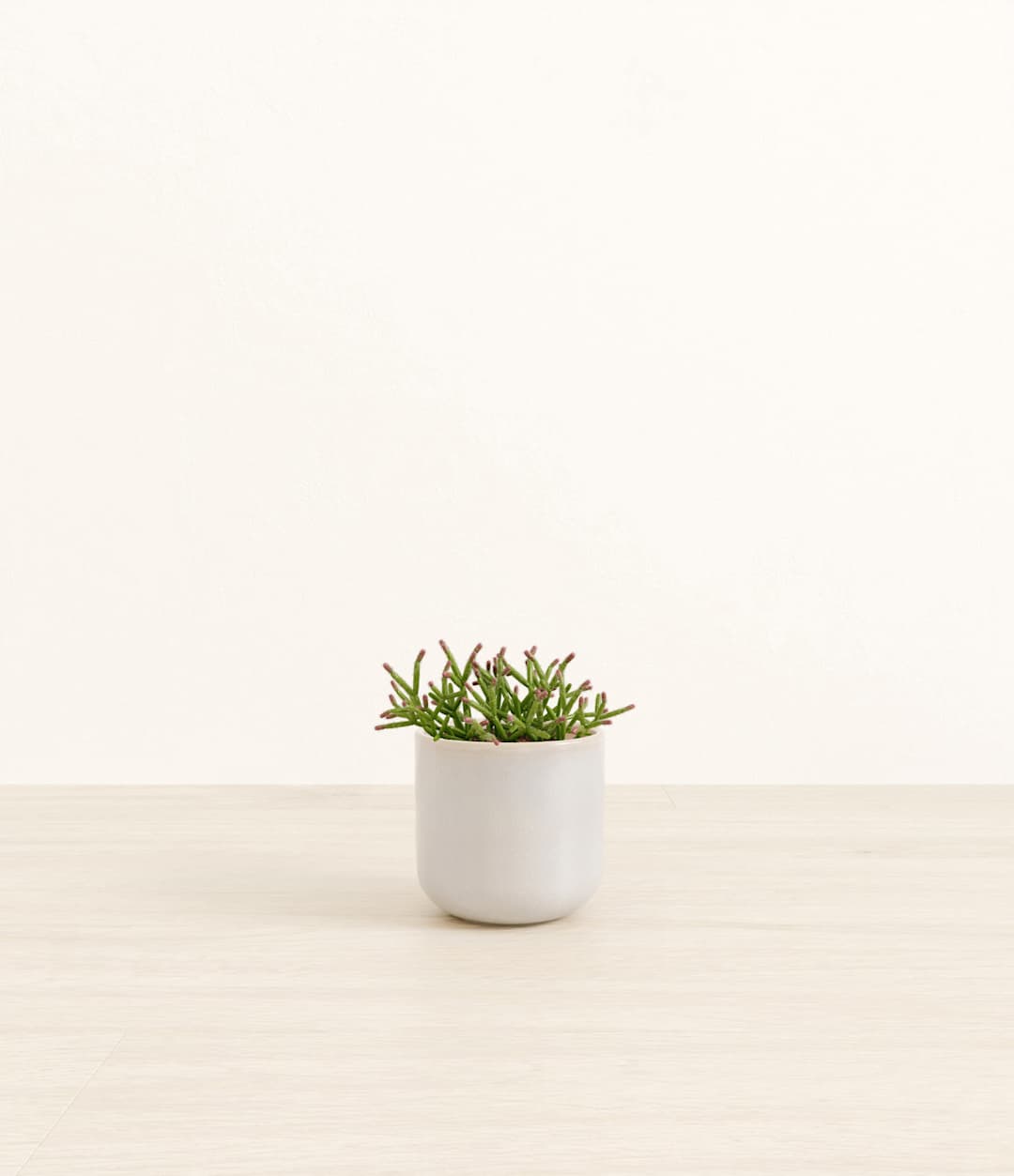About Mistletoe Cactus
A magnificent plant with an extraordinary leaf structure, the Mistletoe Cactus is admired for its bright green pencil-thin foliage that effortlessly trails. Potted in a premium quality self-watering pot with a soft matte finish, this exquisite plant can reach up to 6 feet indoors.
Originating from South America, Central America, and Africa's subtropical climates, this epiphytic plant typically grows perched in trees beneath dense forest canopies - where it acquires moisture and vital nutrients through the air around it as well as its host plant.
The low-maintenance mistletoe cactus is ideal for growing indoors. Unlike its epiphytic cousins, such as Christmas or fishbone cacti that are often grown for their attractive flowers, the mistletoe offers an alternative by being grown primarily for its foliage; it produces small flowers during spring months which tend to be quite insignificant relative to other varieties.
Other common names
- Rhipsalis oblonga
- Rhipsalis ramulosa
- Rhipsalis burchellii
- Cactaceae
- Mistletoe cacti
- Rhipsalis pilocarpa
- Coral cactus (rhipsalis cereuscula)
- Rhipsalis cereuscula
- Rhipsalis horrida
- Rhipsalis horrida
How Often Should I Water My Mistletoe Cactus
When it comes to Mistletoe Cactus, self-watering is the preferred method, as the frequency of manual watering depends on your home's relative humidity, temperature, and other factors. With easyplant's self-watering pot, watering your Mistletoe Cactus is simple. Make sure to fill the easyplant reservoir once a month, and you're all set!
Without an easyplant pot, you'll need to water your Mistletoe Cactus once a week or whenever the soil becomes dry. Aim for slightly moist soil, but make sure to give your mistletoe cactus plant enough time to dry out between waterings. Because this species requires different watering schedules when flowering, self-watering is the preferred option. As your plants enter the flowering season (spring, summer), you should water them more frequently to replicate their natural environment and encourage blooms during spring. During the pre-flowering period, however, decrease the amount of watering until just around half an inch of soil is dry before wetting it again. After flowering has finished, water to keep the soil barely moist for 3 to 6 weeks.
Mistletoe Cactus Light Needs
Mistletoe Cactus grows best in a space with bright indirect light, where the sun rays are diffused, and can also adapt to spaces with medium to low light. Avoid placing it in spaces without natural light or with direct sunlight.
Unlike most desert cacti, the Mistletoe Cactus is sensitive to direct sunlight and prefers a spot with medium to bright indirect light, where the sun rays are diffused. It can also adapt to lower light locations, though growth will certainly slow. For optimal growth, grow this indoor plant in low to medium light, and it can thrive in artificial lighting. It can take small doses of direct sunlight indoors, particularly in Northern climates, yet will do fine without bright light. Placing mistletoe cactus near an east-facing window with a sheer curtain is ideal, yet avoid direct sunlight as this can cause sunburn. If you notice discoloring (reddish color) on your mistletoe cactus’ foliage, it is likely a sign of too much sun exposure - move it to a location with less light.
Mistletoe Cactus Plant Care
Rotate your mistletoe cactus around 1/4 turn monthly to ensure even growth. Provide the plant with extra nutrition during its flourishing season (spring and summer).
To prevent pest infestation, keep the cactus in a well-ventilated area. To ensure the healthy growth of your plant, make sure to keep an eye out for pesky Mealybugs and Scale that may inhabit its nooks and crannies.
Look for white, cottony masses on stems, leaves, and branches, or small, crawling insects with segmented bodies and wipe them off with a damp cloth, spray with a mixture of water and dish soap, or use neem oil as a natural solution. Additionally, it's important to maintain a temperature above 10℃ (50℉) at all times.
How Big Do Mistletoe Cactus Plants Grow?
This epiphytic cactus is characterized by its slow growth rate and pale green stems that typically droop downwards, making it ideal for creating a trailing effect.
The Mistletoe Cactus can reach heights of up to 30 feet with narrow 0.2-inch diameter stems. In the wild, this plant naturally grows attached to other plants, such as rotting leaves and moss in rainforests; therefore, when caring for this unique species at home, ensure you utilize soil replicating those natural conditions.
It may take between 5 - 8 years to reach its ultimate height, but when given the right conditions, this species can survive up to twenty-five years or more.
Temperature & Humidity
To keep your mistletoe cactus thriving, ensure it is placed in temperatures between 60-80 degrees Fahrenheit (16-27 degrees Celsius). You may have to give the plant some extra humidity if the stems start to dry out. This cactus thrives as a houseplant in humid environments, and you can give it a boost by grouping it with other plants or utilizing a humidity tray. Providing the perfect level of humidity to your mistletoe cactus is essential for successful growth, so aim to keep a relative humidity around them at 50%.
Are Mistletoe Cactus Toxic for Pets & Kids?
Not only is mistletoe cactus safe and non-toxic for human contact or consumption, but it's also pet friendly. All parts of the mistletoe cactus, including its roots and leaves, are safe to touch and pose no risk of harm to children or pets.
This makes the Mistletoe Cactus a great choice for households with small children or animals. This species has no spines to worry about, making it a perfect addition to any home.
Troubleshooting Common Problems with Mistletoe Cactus
As long as they’re grown in their preferred conditions, Mistletoe Cactus plants have very few problems. That being said, If you notice your mistletoe cactus' stems turning brown and crispy at the tips, it's likely due to under-watering or inadequate humidity. To prevent this issue in the future, ensure that your plant is exposed to sufficient moisture levels and away from sources of dry air like heating or cooling vents.
Wilted stems with mushy bases are a hint of overwatering and root rot. Unfortunately, once it's started rotting, there is no going back - remove any affected parts and cut away the rotted roots. To stop this from occurring again, ensure your pot has proper drainage and use a soil mixture that drains quickly; additionally, allow for 1-2 inches of dryness between waterings.
Frequently Asked Questions about Mistletoe Cactus Plant
How often should I refill the self-watering planter for my succulent?

Only once every 2 months! Our self-watering system ensures your succulent gets the exact amount of water it needs.
Why don't easyplant pots have drainage holes?

Our innovative self-watering design maintains optimal soil moisture without drainage holes, ensuring healthy roots and a clean, mess-free experience.
What makes easyplant succulents different from regular succulents?

easyplant succulents are specially chosen for indoor success, come pre-potted in optimal soil, and utilize our self-watering technology to prevent common issues like overwatering and root rot.
Is Mistletoe Cactus hard to grow?

The Mistletoe Cactus is easy to grow. They require medium indirect light, temperatures between 60-80 degrees Fahrenheit (16-27 degrees Celsius), and occasional watering throughout the growing season. It's important to keep an eye out for pest infestation and maintain a relative humidity around them at 50%.
Is Mistletoe Cactus poisonous?

No, mistletoe cactus is non-toxic and safe for human contact or consumption. All parts of the plant, including its roots and leaves, are pet friendly and pose no risk of harm to children or pets.
How do you take care of a Mistletoe Cactus?

Mistletoe Cactus need medium, indirect light and occasional watering throughout the growing season (spring-summer). During the dormant period (fall-winter), if you're not using an easyplant, water it only when the top inch of soil is dry. Rotate your mistletoe cactus around 1/4 turn every month to ensure even growth.


